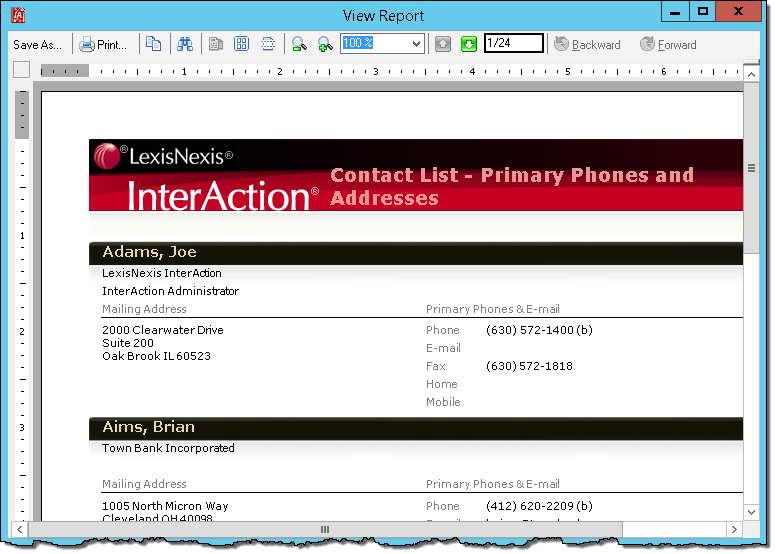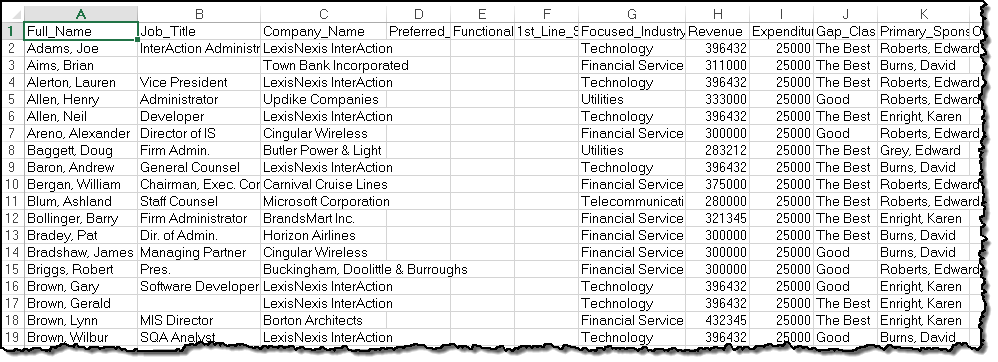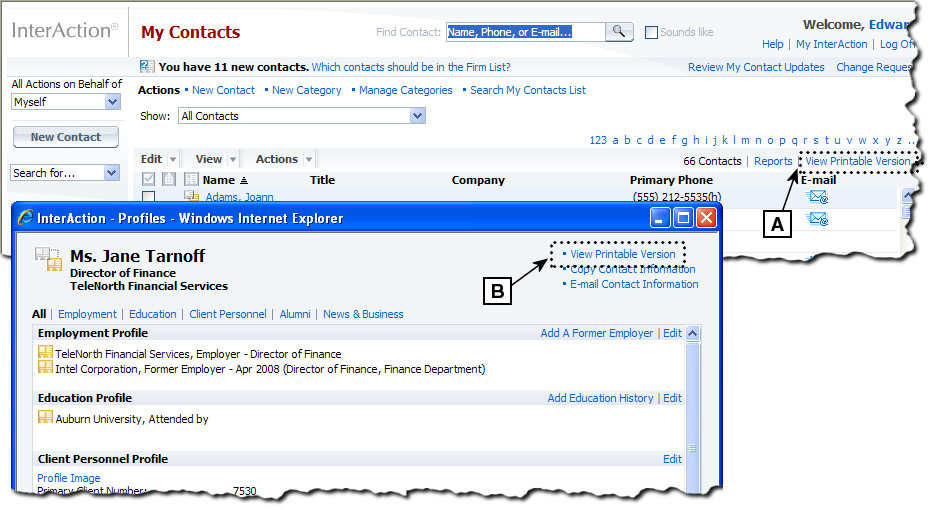Section Topics
Overview of Viewing and Printing Reports in the Web Client
The InterAction Web Client provides you with several ways to print and use InterAction information. This includes the following reporting options:
- You can view and print a variety of reports for individual contacts and for lists of contacts. For details, see Viewing and Printing Reports for Contacts.
- You can view and print a variety of reports for individual activities and appointments and lists of activities and appointments. For details, see Viewing and Printing Activity and Appointment Reports.
- If your organization has licensed one of the related modules, you can view and print a variety of reports for matters, opportunities, and engagements. For details, see the help for your module.
Note: The specific reports available to you depend on how InterAction has been configured for your organization.
See the following overview topics:
- Selecting a Report from the Report Chooser
- Adding Reports to Your Favorites List
- How the Reports Are Displayed
- Viewing a Printable Version of Information
- Problems with Blank Names on a Report
Note: In addition to viewing and printing reports, you can use your contacts to create letters, envelopes, and labels.
Selecting a Report from the Report Chooser
To access most of the reports available in InterAction, you open the Report Chooser. This dialog box lists all the reports you have access to use for the type of InterAction information. For example, when viewing a contact list, the Report Chooser displays contact reports, while it displays activity/appointment reports when you are viewing a list of activities.
You can filter the list of reports to include just those that apply to people, companies, or both. The individuals configuring the reports for your organization determine what kind of contacts the report is for when designing the report.
Some reports let you set additional options for how they are displayed. For details, see Personalizing Your Reports.

[A] This list contains all applicable reports available to you. Reports are organized into categories defined by your organization. You can filter the list to include reports applicable to people, companies, or both.
[B] The Description field displays the description for the selected report.
[C] If the selected report can be customized, use this link to set options for the report.
[D] Review the contacts to be included in the report here.
[E] Choose View Now to open the selected report, or choose Send to Me to have the report generated behind the scenes and sent to you in an email (only available if your organization has configured InterAction with email report delivery).
Note that pop-up blocker software can interfere with the display of a report after selecting it to display from the Report Chooser. To resolve this issue, either remove the pop-up blocker software, disable it, or see the documentation for the pop-up blocker.
Adding Reports to Your Favorites List
If you use some reports frequently, add these reports to your My Favorite Reports list. This list is always at the top of the Report Chooser so favorite reports are easy to find.
To add a report to your favorites, choose the Add to my favorites link in the Description area for the report.

Adding Reports to My Favorite Reports
[A] Your favorites display at the top of the Report Chooser.
[B] To add a report to your favorites list, select it and choose Add to my favorites.
How the Reports Are Displayed
Depending on how InterAction has been configured, there may be several different types of reports available to you. Some reports produce a PDF document which can be viewed using Adobe® Acrobat® Reader®. Others export data to other applications.
For example, the out-of-the-box Contact List - Primary Phones and Addresses report generates a PDF document. You can open it directly or save it to your computer for later use. Once you open the report in Acrobat Reader, you can print it as you would any other PDF file.
In contrast, the out-of-the-box Marketing List Contacts report shown below is configured to export the information to Microsoft Excel. From here you can use any normal Excel features, such as sorting or searching through the results.

Sample Report Generated as a PDF Document

Sample Report that Exports to Microsoft Excel
The Report Chooser indicates the type of each report with an icon. Since your organization can configure the set of reports available in the Web Client, you may not see some of these report types:
| Icon | Description |
|---|---|
|
|
InterAction report The report generates a PDF document. You can choose whether to open this document directly or save it to your computer. You must have Adobe Acrobat Reader installed on your machine to view these reports. |
|
|
Microsoft Excel export The report exports data to Microsoft Excel. You need to have Microsoft Excel on your machine to view this type of report. |
|
|
Microsoft Access Database export The report saves the data in a Microsoft Access Database (.MDB) file. You are prompted for the location on your computer to save the file. You need to have Microsoft Access on your machine to view this type of report. |
|
|
XML - When you choose View Now, the data displays in XML format in your web browser. |
|
|
Microsoft SQL Reporting Services [SSRS] report The report opens Internet Explorer. |
|
|
Crystal Report These reports were created in Crystal Reports and are opened in the Crystal Reports Viewer. |
|
|
HTML Report The report opens just as an HTML page in your browser. |
Depending on how InterAction has been configured for your organization, you may be able to email reports to yourself or another user for whom you are a proxy. In this case, the report is generated behind the scenes and is sent to you as an email attachment. For details, see Emailing Reports .
Viewing a Printable Version of Information
Many areas of the Web Client include View Printable Version links. You can use these links to quickly display information in a format useful for printing.
On a list of items, such as a list of contacts, the View Printable Version link automatically opens one of the same reports you can view from the Report Chooser. This gives you a shortcut to the most commonly used report for that list.
The specific report opened by the link depends on the list. For example, choosing View Printable Version from the My Contacts list opens the Contact List - Primary Phones and Addresses report, while the same link from a working list opens the Working List Contacts report.
For other areas of the Web Client, the View Printable Version links display a printer-friendly version of the information you are viewing. These reports are displayed on a browser page. You can print the information from this page.
On dialog boxes, such as the Profiles dialog box, the View Printable Version link displays the same information you see in the dialog box. See the following:
- Print All the Profiles for a Specific Contact
- Print All Phones and Addresses for a Specific Contact
- View or Print a Single Activity or Appointment
On the My Alerts page, the View Printable Version link displays the same information you see in the list of alerts, while the Reports link opens the normal report chooser for printing a contact report. For details, see Print Your Alerts.
On the Related People, Companies and Organizations section of the overview page, the View Printable Version link displays the list of relationships shown on the page, while the Reports link opens the normal report chooser for printing a contact report. For details, see Print the List of Relationships for a Contact.

View Printable Version Links
[A] View Printable Version link on a list of contacts. This opens one of the same reports available in the Report Chooser. In this example, the View Printable Version link for the My Contacts list opens the Contact List - Primary Phones and Addresses report (Sample Report Generated as a PDF Document).
[B] View Printable Version link on the Profiles dialog box for a contact. This provides a printable view of the same information shown in the dialog box. In this example, the printable view includes information from all the sections (Employment, Education, Client Personnel, and Alumni).
Problems with Blank Names on a Report
Depending on how your administrator has configured the reports in your environment, you could encounter issues with contacts saved in other languages.
Unicode fonts are fonts that can display text in any language. For example, if you have contacts in Japanese, German, and English in your report, Unicode fonts can display all of these contacts in their respective languages.
If the report you are trying to view was not designed using a Unicode font, text written in foreign characters will not display in the PDF viewer in the InterAction Web Client. For example, if you have a report that lists ten contacts in English and one contact in Japanese, the contact saved in Japanese will be blank in the report.
This issue must be corrected by a system administrator.
